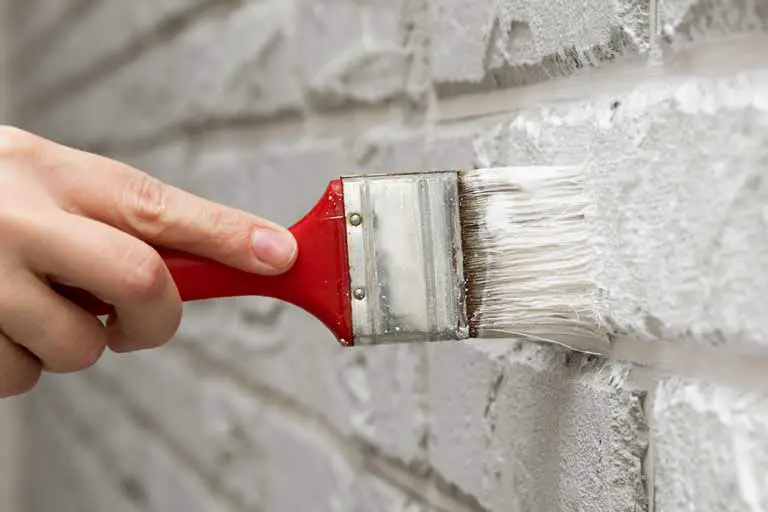
If you’re considering giving your home or office a fresh coat of paint, you may have come across the terms whitewash and limewash. While they may sound similar, they are two different types of paint with distinct characteristics. Understanding the differences between whitewash and limewash can help you decide which one to use for your project.
Whitewash is a type of paint made by mixing water and white paint. It has been used to give walls, ceilings, and furniture a bright, clean look. Whitewash can be used on non-porous surfaces such as metal and glass, whereas limewash will need extra additives to do so. It provides a weathered and traditional look, but the final result depends on the application.
On the other hand, limewash is a type of paint made by mixing lime putty, water, and natural pigments together. It has been used for centuries to give walls, ceilings, and furniture a natural, matte finish. Limewash is ideal for porous surfaces such as brick and lime plaster. It can be built up over many coats, with each coat adding to the texture and depth of colour. Limewash is also environmentally friendly and can create a rustic, vintage, or Mediterranean look, depending on the application.
Whitewash vs Limewash
If you want to give your walls a fresh, new look, you may be considering whitewashing or limewashing. While both are water-based paints that create a chalky texture and come in natural colours, there are some key differences between the two. This section will explore what whitewash and limewash are and what sets them apart.
What is Whitewash?
Whitewash is a water-based paint that creates a matte, chalky finish on walls, furniture, and other surfaces. It is made by mixing white water-based paint with water and is often applied to porous surfaces like brick, stone, and wood.
One advantage of whitewash is that it’s easy to apply and dries quickly, making it a popular choice for DIY projects. Whitewash can last for 20+ years in some cases.
What is Limewash?
Limewash is similar to whitewash in that it is a water-based paint that creates a chalky texture and comes in natural colours. However, there are some key differences between the two.
Limewash is made by mixing lime putty (fat lime), water, and pigments and is often used on historic buildings and other structures. It has been used for centuries and is known for its durability and long-lasting finish.
One of the advantages of limewash is that it is non-toxic and eco-friendly, making it a great choice for those concerned about its environmental impact. It is also breathable, allowing moisture to escape from the walls, preventing mould and mildew from forming.
Related article: What is Limewash? An Overview of This Traditional Paint

Whitewash vs Limewash: Differences
While whitewash and limewash are water-based paints that create a chalky texture and come in natural colours, the two have some key differences.
One of the main differences is the ingredients used to make each paint. Modern whitewash is made with water-based paint, while limewash is made with mature fine lime putty. This difference in ingredients can affect the texture and durability of the paint.
Another difference is the application process. Whitewash is quick-drying and is very easy to apply. Limewash can be more difficult to apply correctly. In addition, limewash takes around 24 hours to cure between coats.
While curing, limewash must be monitored to ensure its dries at a nice slow, even rate. If not, it must be gently mist sprayed to ensure correct curing. Because of this, limewash involves more work. But, in my option, in the end, limewash creates a far superior finish!
In terms of eco-friendliness, both whitewash and limewash are non-toxic and environmentally friendly. However, limewash is often considered more eco-friendly due to its breathable nature and long-lasting finish.
Overall, whitewash and limewash are great options for those looking to give their walls a fresh, new look. When deciding between the two, consider each paint’s texture, durability, and eco-friendliness to determine which one is right for you.
The History of Whitewash
Whitewashing has a long history dating back several centuries. Traditional whitewash was essentially just white limewash. It was often used in cow barns and on farms to help keep the walls as hygienic as possible. These whitewashes were often lower quality and needed to be regularly re-applied.
The words whitewash and limewash were often used interchangeably as they used to be essentially the same paint. Whitewash was just white limewash, its natural colour, before adding any pigments.
One of the key differences between traditional and modern whitewash is the ingredients used. While traditional whitewash is made using lime and water (limewash), modern versions often use white paint as the main ingredient. This gives the whitewash a slightly different appearance.
Another difference is the texture of the whitewash. Traditional whitewash has a rougher, chalky texture that is created by the lime in the mixture. Modern whitewash is smoother and more uniform, thanks to the use of paint and other additives.
Despite these differences, modern whitewash is still a popular choice for homeowners looking to give their surfaces a fresh, clean look. It can be used on various surfaces, including walls, ceilings, and furniture, and can be customized to achieve different finishes and textures.
Whether you prefer the traditional look of lime-based whitewash (or just white limewash) or the modern convenience of paint-based formulas, there is a whitewash option that will suit your needs.
Benefits of Using Whitewash and Limewash
When painting your walls, there are many options to choose from. Whitewash and limewash are two popular choices that offer several benefits. Here are some of the advantages of using whitewash and limewash for your walls:
Durability
Whitewash and limewash are both very durable paints. They can withstand harsh weather conditions and are resistant to peeling and cracking. This makes them ideal for use on outdoor and indoor walls exposed to high levels of moisture or humidity.
Easy to Apply
One of the main benefits of whitewash and limewash is how easy they are to apply. They can be applied using a brush or sprayer and require very little preparation. Unlike other paints, there is no need to apply a primer or sand the surface beforehand. This makes them a great option for anyone looking to save time and money on their painting project.
Hypoallergenic
Limewash is a hypoallergenic paint, meaning it is less likely to cause allergic reactions. It’s made from natural ingredients like lime and water and contains no harmful chemicals or toxins. This makes it a great option for anyone with allergies or sensitivities to traditional paints.
Maintainability
Another benefit of whitewash and limewash is how easy they are to maintain. They can be easily touched up or repainted if needed and do not require any special cleaning products or techniques. This makes them a great option for anyone looking for low-maintenance paint that will last for years to come.
In summary, whitewash and limewash offer several benefits, including durability, ease of application, hypoallergenic properties, and maintainability. If you are looking for a natural, eco-friendly paint that will stand the test of time, whitewash or limewash may be the perfect choice.
Related article: Limewash Pros and Cons: A Comprehensive Guide

Surfaces for Whitewashing and Limewashing
When choosing between whitewashing and limewashing, the surface you are working with plays a crucial role. While both paints can be used on various surfaces, each has its advantages and disadvantages. Here are some of the surfaces that are suitable for whitewashing and limewashing:
Porous Surfaces
Porous surfaces such as brick, stone, and lime plaster are ideal for both whitewashing and limewashing. These surfaces absorb the solution, allowing it to penetrate deeply and create a durable, long-lasting finish. However, it’s important to note that limewash is better suited for porous surfaces as it is more breathable and allows the surface to retain its natural texture.
Lime Plaster or Render
Lime plaster or render is another surface suitable for whitewashing and limewashing. These surfaces are often found in historic buildings and can be difficult to work with. However, both whitewash and limewash can be used to create a beautiful, natural finish that enhances the character of the building.
Related article: What Are The Best Paints For Lime Plaster?
Previously Painted Brick
Whitewash is the better option if you’re working with previously painted brick. Whitewash sits on top of the surface, creating a finish that allows the natural texture of the brick to show through. On the other hand, limewash can be difficult to apply to previously painted surfaces and may result in a patchy finish.
If you want to limewash, all other paints and previous finishes must be removed first.
Brick
If you’re working with brick, limewash is the better option. Limewash can penetrate the surface, creating a more durable finish that won’t peel or chip over time. However, it’s important to note that limewash may not be suitable for all surfaces, so it’s important to test a small area before applying it to the entire surface.
In summary, both whitewashing and limewashing can be used on various surfaces, but each has advantages and disadvantages. When choosing between the two techniques, it’s important to consider the surface you are working with and the desired outcome. By doing so, you can create a beautiful, natural finish that enhances the character of the building.
Ingredients and Pigments
Whitewash Ingredients and Pigments
One of the main ingredients in modern whitewash is white paint. This is typically watered down to create a semi-transparent, chalky white appearance that allows the substrate, such as brick, to show through. The type of paint used can vary, but most people use white latex paint. The paint is mixed with water, adding more water to create a thinner consistency if needed.
Limewash Ingredients and Pigments
Limewash comprises hydrated lime (lime putty) and water, but it differs from whitewash in that it contains natural pigments. These pigments are derived from minerals, such as iron oxide, and are added to the mixture to give the paint its colour. Limewash is available in a wide range of colours. The pigments are mixed with the lime and water to create a paint that can be applied to walls or other surfaces.
Limewash has a high pH level, which makes it hypoallergenic, odour-resistant, and mould-resistant. It is also fungal and insect-resistant, making them ideal for use in outdoor settings. Limewash is known for its durability and longevity, and it is often used on historic buildings and monuments to preserve their original appearance.
In conclusion, while whitewash and limewash share similar ingredients, adding natural pigments to limewash gives it a wider range of colours and sometimes a more durable finish.
Conclusion
By now, you should clearly understand of the difference between limewash and whitewash. While both paints have their unique benefits, they also have their differences.
Limewash is a traditional paint that has been used for centuries. It is made from natural ingredients and is environmentally friendly. Limewash is also long-lasting and can withstand harsh weather conditions. It is ideal for porous surfaces such as brick and lime plasters.
On the other hand, whitewash is a more modern paint for indoor and outdoor surfaces. It is easy to apply and dries quickly. Whitewash is also long-lasting and can smooth over rough surfaces. It is ideal for a wide range of surfaces.
When deciding which paint to use, you should consider the desired look, the surface you are painting, and the allergy factor. If you or someone in your household has allergies, then you should opt for limewash as it is made from natural ingredients.
In conclusion, both limewash and whitewash have their unique benefits and are suitable for different surfaces and situations. It is important to consider your needs and preferences before choosing which paint to use.

